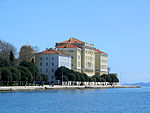University of Zadar
This articleneeds additional citations forverification.(November 2012) |
Sveučilište u Zadru | |
 | |
| Latin:Universitas Studiorum Jadertina | |
| Type | Public |
|---|---|
| Established | 2002 (14 June 1396 as a theological seminary) |
| Rector | Dijana Vican |
Academic staff | 440 (2022)[1] |
Administrative staff | 204 (2022)[1] |
| Students | c. 6,000 (2022)[1] |
| Location | , |
| Affiliations | EUA BUN |
| Website | unizd.hr/ |
TheUniversity of Zadar(Croatian:Sveučilište u Zadru,Latin:Universitas Studiorum Iadertina) is apublic universitylocated inZadar,Croatia.The university in its present form was founded in 2002, but can trace its lineage to 1396, thus making it the oldest higher education institution inCroatia,and one of the oldest inEurope.
History
[edit]
The university was originally founded by theDominicansin 1396 asUniversitas Iadertina,atheological seminary,Iadera being the Latin name for Zadar. It was a continuation of theUniversity of Dyrrachium,inDurrës(Dyrrhachium),Venice,thenRepublic of Venice,which had been created around 1380, and then transferred to Zadar in 1396, amid the mounting Turkish threats in Southeastern Europe, thereby becoming the University of Zadar.[3]
Consequently, it became the first institute of higher learning in the country. In 1807, it ceased being an independent institution and its functions were taken over by other local universities. In 1956, theUniversity of Zagrebreconstituted it as a satellite campus for theFaculty of Philosophydivision. The faculty later became part of theUniversity of Split.Finally, in 2002, more than six centuries after the university's initial founding, theCroatian Parliamentpassed an act to allow for its full-fledged refounding. Now independent, the renewed University of Zadar opened its doors to students in January 2003.[4]
Since its reestablishment, the university has continued to grow. It had implemented theBologna Processfor the academic year of 2005-2006 as part of nationwide reform. A follow-up study showed that the move was beneficial and had improved its profile internationally.[5]This allowed it to engage in collaborative research agreements andstudent exchange programmeswith other reputable universities around the continent. It also has agreements with universities inSouth Americaand theUnited States.
The first Croatian president,Franjo Tuđman,graduated from the University of Zadar in 1965, then part of the University of Zagreb.
Faculties
[edit]Today, the University of Zadar includes 27 university departments:
- Department ofArchaeology
- Department ofClassical Philology
- Division ofGreek Languageand Literature
- Division of Latin Language and Literature
- Department ofCroatian Studies
- Department ofEcology,AgronomyandAquaculture
- Department ofEconomics
- Department ofEnglish Studies
- Department ofEthnologyandAnthropology
- Department ofFrenchandFrancophone Studies
- Department ofGeography
- Department ofGerman Studies
- Department of Health Studies
- Department ofHispanicandIberian Studies
- Department ofHistory
- Department ofHistoryofArt
- Department ofInformation Sciences
- Department ofItalian Studies
- Department ofLinguistics
- Department ofPedagogy
- Department ofPhilosophy
- Department ofPsychology
- Department of Religious Sciences
- Department ofRussian Studies
- Department ofSociology
- Department of Teacher Education Studies inGospić
- Department of Teachers andPreschoolTeachers Education
- Division ofElementary SchoolTeacher Education
- Division of Preschool Teacher Education
- Department ofTourismandCommunication Studies
- Maritime department
- Division of Nautical Studies
- Division ofMaritime Engineering
In order to organise and promote scientific research activities, the university has founded four research centres as its constituent units. These include the Centre for Adriatic Onomastic Research, theStjepan MatičevićCentre, the Centre for Karst and Coastal Research, and the Centre for Interdisciplinary Marine and Maritime Research - CIMMAR.
In addition, there are two active centres for professional and teaching activities: the Centre for Gymnastics and Student Sport, and the Centre for Foreign Languages.
Rankings
[edit]| University rankings | |
|---|---|
| Regional – Overall | |
| QSEmerging Europe and Central Asia[6] | 301-350 (2022) |
Acknowledgements
[edit]- City of Zadar Award(2012)[7]
See also
[edit]References
[edit]- ^abcO nama (2012-06-14)."Povijest".Unizd.hr.Retrieved2022-01-21.
- ^"U Crkvi sv. Dominika otvorena Državna smotra učenika".057info.2017-04-28.Retrieved2023-08-06.
- ^"University of Zadar: About us".Unizd.hr.Retrieved2016-03-08.
- ^"University of Zadar"(PDF).Archived fromthe original(PDF)on 2017-01-01.Retrieved2012-11-27.
- ^Bologna Process at the University of Zadar - A year later.November 2006.
- ^"QS World University Rankings-Emerging Europe & Central Asia".Retrieved15 January2023.
- ^"Dobitnici javnih priznanja Grada Zadra u 2012. godini".grad-zadar.hr(in Croatian). City of Zadar. 30 November 2012.Retrieved29 June2023.
External links
[edit]- University of Zadar Website(in Croatian and English)
- Info Zadar(in Croatian)





